
Don Line Cavalry
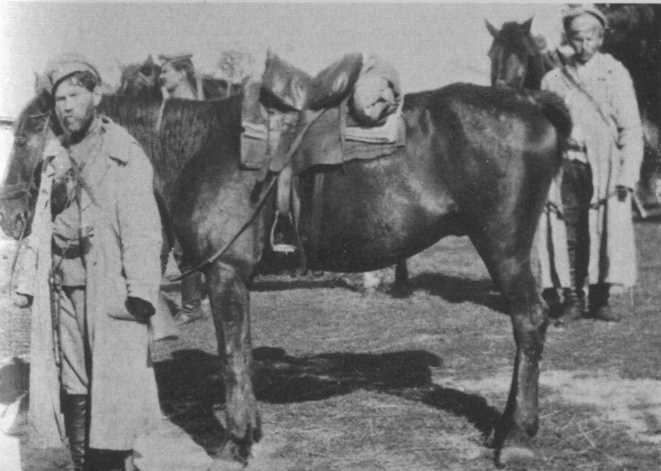
Williamson's Cossack escort, as photographed by him. Note the Cossack style saddle.
The Don fielded a large number of cavalry units in the Great War and did so again in the Russian Civil War, many of them revived Imperial units.
4th Don Cossack Regiment
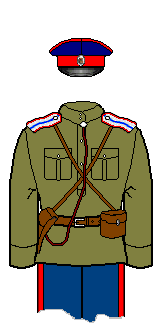 |
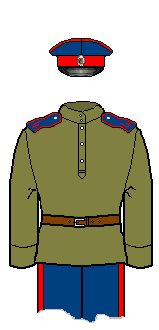 |
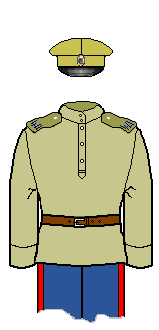 |
 |
|---|---|---|---|
| Officer | Trooper | Trooper field dress | Papakha: men and officer |
The Host colours for the Don were dark blue and red.
WWI field dress would have all the coloured clothes replaced by khaki, but the Don Cossacks were known to retain their coloured items. Williamson speaks of men in "blue or green trousers with a wide red stripe".
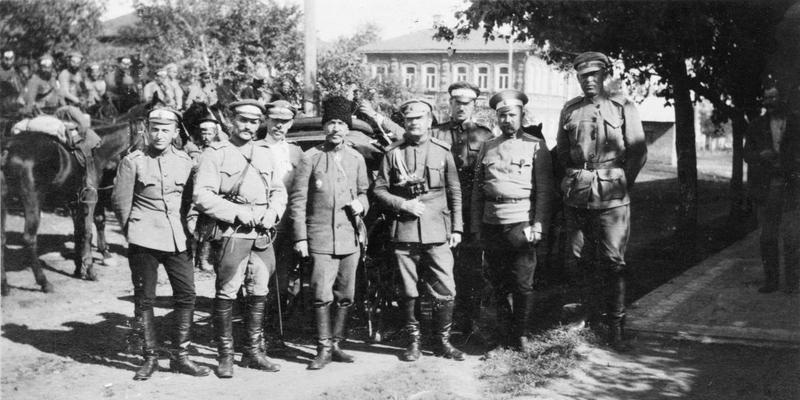
Photos also clearly show that many men wore white bands on their khaki caps, either the whole way or only the front part, as in the photo above. Some also have dark trousers.
Uniform Details
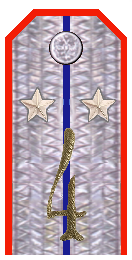 |
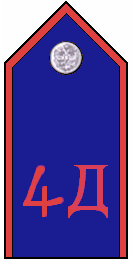 |
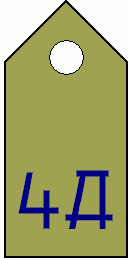 |
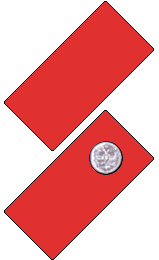 |
| Shoulderboards: Junior Lieutenant | Shoulderboards: Trooper | Shoulderboards: trooper field version | Greatcoat collar tabs |
Dress shoulderboards were blue piped red and the unit monogram in red for troopers. Buttons and officer lace were silver. Officer's monogram in and rank markings were in gold.
Field shoulderboards had the number stencilled or inked in dark blue.
Up to 1915 the Don line regiments simply had their number as their cipher. After 1915 they were meant to add a Cyrillic D ( Д ) as well. Photos don't show many complying, but it was possibly difficult for officers to get the requisite metallic letters to add during wartime.
Most Don cavalry wore a furazhka peaked cap. They are sometimes also seen in papakha, generally quite low ones. The dress version had red cloth for men with a white/silver cross inside a ring for officers. The field version was plain khaki, although officers might have a cross in white.
Some Don Sotnias were dressed in British uniforms. Where possible they preferred to retain Russian caps and boots, however.
Some sources give the Don bashlyk was black or dark grey, with black trim (or black/gold for officers).

This man to the left is wearing a uniform remarkably like that of the Civil War era 4th Don Cossack Regiment (from white-guard.ru).
The cap is the regulation blue with red band and piping, although during the Civil War period it would often have the stiffener removed and so be a much softer shape.
The shoulderboard is piped red around the outside and blue down the middle. His rank is staff-captain (4 stars on two stripes). He doesn't have the silver lace, but has opted for the khaki representation. Stars and number are gold, showing he is cavalry.
The cipher would appear to be 41, where it would be 4Д for the 4th Don Cossack Regiment.
The greatcoat is the WWI other ranks version, the proper officer coat was a pale grey like the man in the background. The black fabric is a bashlyk crossed across his chest.
What is probably a pistol lanyard comes from his neck, and officially such a man would carry a pistol not a carbine.
History in the RCW
The 4th Regiment of the Don Cossack Host formed in 1917 and immediately took the honorific of the Imperial unit with that number, "Ataman Platov". It became part of the Young Army, so was filled up with young recruits. By 1919 it was in the Second Brigade of the 1st Don Cavalry Division, beside the Kalmyks. This was the strike division of the Don Army and saw a disproportionate amount of action. In October 1919 it had 298 bayonets, 180 sabres, 8 MGs – typically for a Don unit it combined infantry and cavalry in proportion to the number of horses available.
The 4th Don Horse Regiment was reformed in the Crimea, now in the 2nd Don Division. This time it was named after Ataman Nazarov, who had been shot by the Soviets, and the 5th Regiment became Ataman Platov.
Flags
The 4th Don Regiment had a 1900 Model flag, with St George differences. A large orange St George ribbon was tied to the pole with a bow at the top. It would have looked something like this:
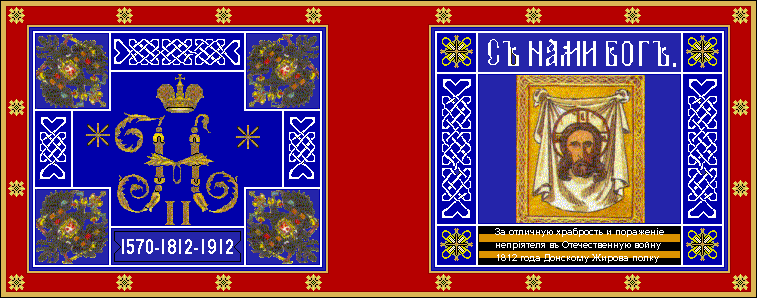
(The Imperial 2nd to 10th Don Regiments all had very similar flags, but with different dates and inscriptions.)
An actual flag of the 4th Don Regiment has survived. Although this one is clearly intended to be carried vertically rather than flown off a pole and presumably pre-RCW, it might still make a nice variant:
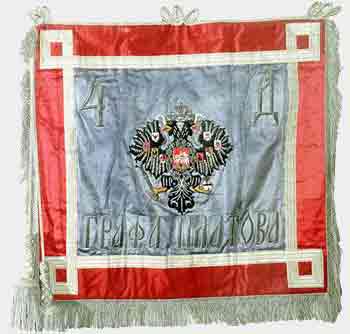
The 4 and Д are embroidered on at the top. The text along the bottom is "ГРАФА ПЛАТОВФ" being "Grafa Platova", i.e. Count Platov, the ataman the unit was named after.
Colours are blue in red, albeit quite faded, which one would expect. Lettering should be in gold.
The official HQ field flag was a red diamond inside blue with the unit's number and distinguishing letter. There appears to have quite a lot of flexibility about exactly how the what letters were added and how they were arranged, but it would have been something like:
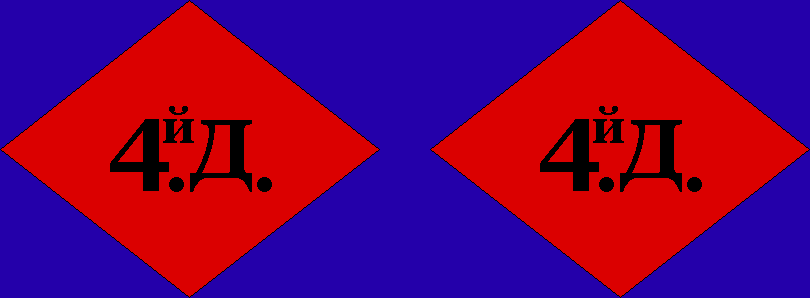
(We know the 9th Don Cossack unit this style flag, see below).
The Tsarist battle standard, to mark the commander's location, was a dark blue square with the unit's number in red. It followed the shoulder monogram, so presumably added a Д in 1915.
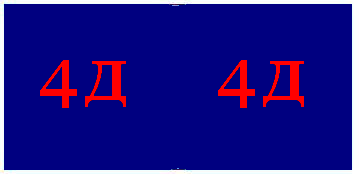
Sotnia flags had dark blue on top, and sotnia colours underneath:

Other Similar Units
All Don Horse Regiments numbered greater than 4 would have looked the same. We assume that the regiments fighting as partisans would also look similar, since that is the uniform the men would have had.
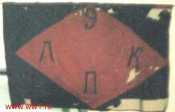
The flag of the 9th Don Cossacks has survived the Civil War.
It is the regulation issue red diamond in dark blue, with a cipher of 9 Д К П standing for the 9th Don Cavalry Regiment.
Photos
We have assembed various photographs of Don soldiers in a separate page.